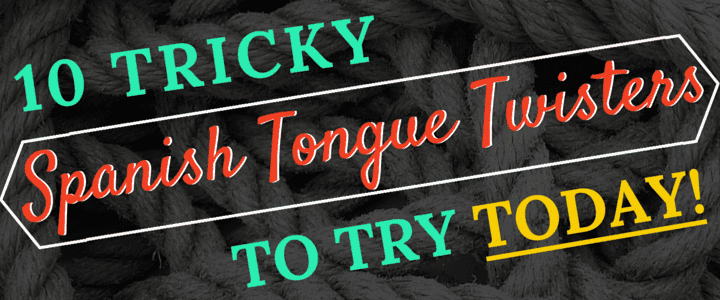Spanish tongue twisters (or trabalenguas) can be very amusing for children and adults alike. But did you know that tongue twisters can also help improve your pronunciation as you’re learning to speak Spanish?
Since tongue twisters have a certain pattern, they can help you practice your oral skills by honing in on one sound at a time. For example, the famous “she sells seashells by the seashore” focuses on the “sh” and “s” sounds.
Not only are tongue twisters fun, they can get pretty competitive if you’re trying them out against your friends and family to see who can say it perfectly with the least amount of tries. A great way to practice your pronunciation and enunciation is by reciting the following 10 Spanish trabalenguas.
Feel free to read them slowly, then practice until you can say them fast. In case you have trouble with the pronunciation, we’ve provided an audio recording for each trabalengua. If you’re new to speaking in Spanish, there is nothing to fear — these are hard even for seasoned veterans!
1) Tres tristes tigres tragaban trigo en un trigal.
This tongue twister focuses on the “tr” sound. The “r” sound is pretty difficult for new Spanish speakers – and even more difficult is the “rr” sound. Try your best to say this tongue twister yourself first, then listen to the audio to see if you got it right.
2) Un perro rompe la rama del árbol.
This tongue twister focuses on the hard “r” sound (same as the “rr” sound). The hard “r” sound seems to be difficult for almost all non-native Spanish speakers. With practice you’ll be able to roll your “r” sounds — just be patient.
3) Buscaba el bosque Francisco, un vasco bizco, muy brusco, y al verlo le dijo un chusco, ¿Busca el bosque, vasco bizco?
This tongue twister focuses on the “b” and “v” sounds, and the “sq/sc” sound. For most people, these sounds are relatively easy and not that difficult to pronounce. This is a bit of a long one; how many tries does it take for you to say this one correctly?
4) Pancha plancha con cuatro planchas. ¿Con cuántas planchas Pancha plancha?
This tongue twister focuses on the “p” and “pl” sounds. These sounds aren’t too difficult for Spanish learners. Nevertheless, it’s a good tongue twister to help with your pronunciation.
5) Cuando cuentes cuentos, cuenta cuantos cuentos cuentas, cuando cuentes cuentos.
This tongue twister focuses on the “cua” and “cue” sounds. The sounds aren’t really difficult to pronounce correctly, however, remember that the “t” and “cua/cue” sounds are heavier than their English counterparts. Beginner Spanish speakers tend to pronounce Spanish sounds softly rather than with the heaviness that’s prominent in the Spanish language.
6) Hoy ya es ayer y ayer ya es hoy, ya llegó el día, y hoy es hoy.
This tongue twister focuses on the “y” sound and the silent/non-existing “h” sound. It’s another fairly simple tongue twister if you take your time. Interesting fact: Some Spanish speakers pronounce the “y” like a “j” in English. For example: “ya es ayer” would sound like “ja es ajer” (phonetically spelled using the English “j” sound).
7) Compré pocas copas, pocas copas compré y como compré pocas copas, pocas copas pagué.
This tongue twister focuses on the “co,” “po,” “pa,” and “é” sounds. It’s definitely a fun one to try with your friends. Remember though, the “é” is the heavy part of the word (where you put more force on enunciating).
8) La sucesión sucesiva de sucesos sucede sucesivamente con la sucesión del tiempo.
This tongue twister focuses on “su,” “ce,” and the overall “s” sound. In Spanish, when a “c” is followed by “e” or “i,” it sounds like an “s.” In this tongue twister, the “s” is very prominent — which can make this one very easy or very tricky.
9) De generación en generación las generaciones se degeneran con mayor degeneración.
This tongue twister focuses on the “ge” and “ción” sounds. This one can be a little difficult, but if you take your time you should be able to get it. Remember, when the “r” is in between vowels, it’s a light “r,” not a hard “r” (“rr”) sound.
10) Juan junta juncos junto a la zanja.
This tongue twister focuses on the “j” sound. It’s short, simple, and pretty easy to read, but nevertheless a fun little sentence. However, don’t be surprised if you mess up on this insidious tongue twister.
Congratulations – you got through every single one! If you had trouble with them, go back through them slowly to make sure you can say all the words, check the pronunciation on the audio files, and then practice until you can go faster. Spanish tongue twisters really are mind over matter!
It also helps immensely to take Spanish lessons with a great tutor, so you can practice speaking in Spanish more and get feedback on your pronunciation. If you can get through all of these tongue twisters, you’ll be well on your way to having excellent Spanish pronunciation!
Suzy S.
